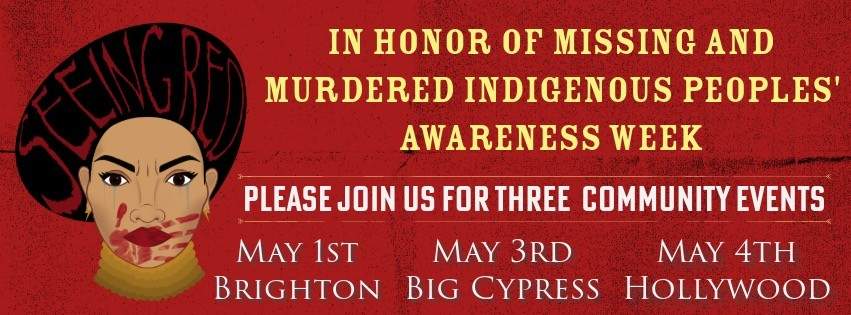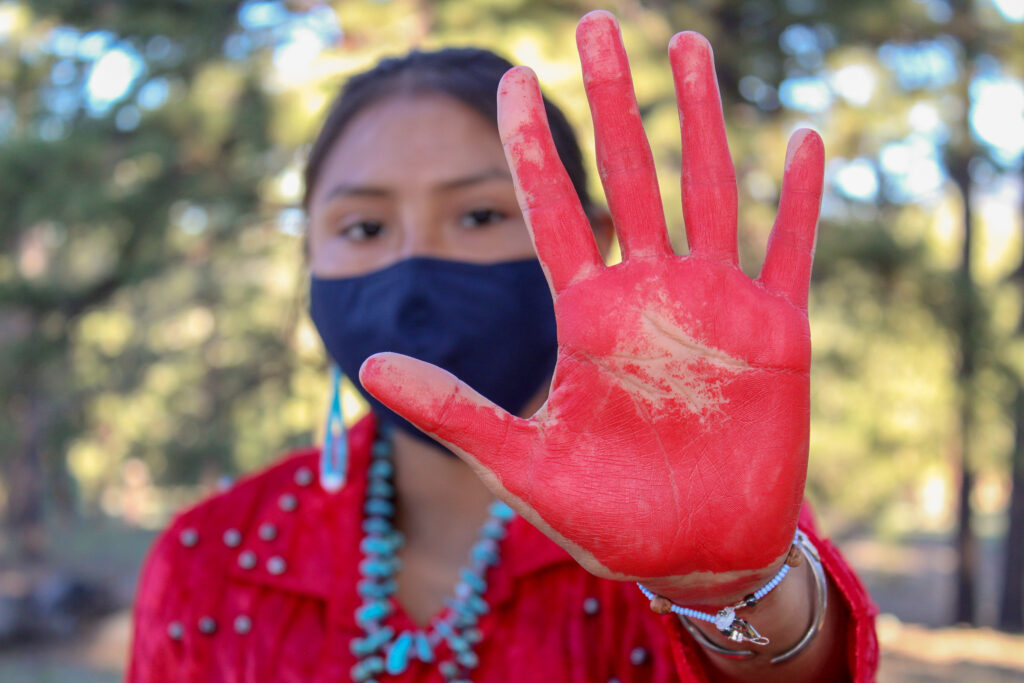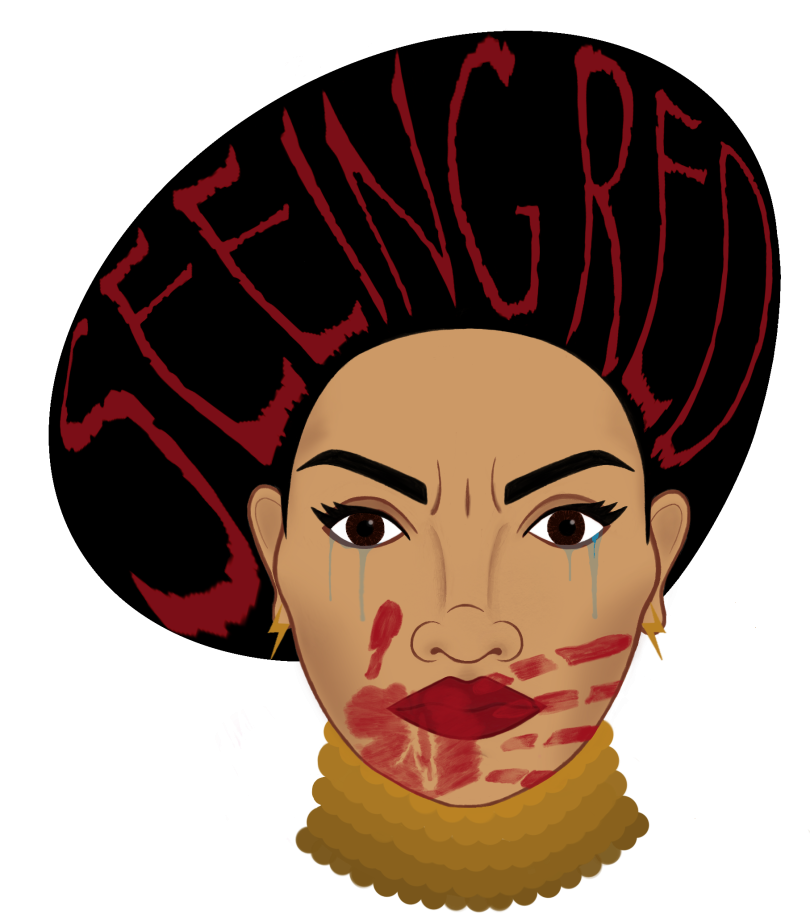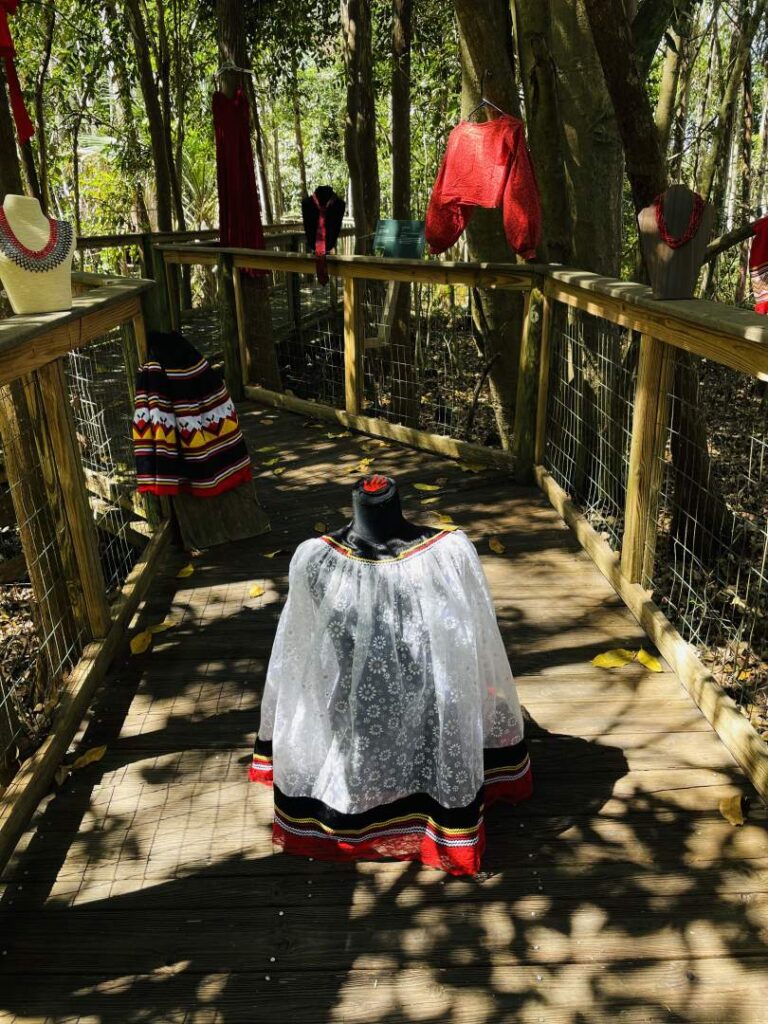
Missing and Murdered Indigenous Peoples Awareness Week
April 29th – May 5th is Missing and Murdered Indigenous Peoples Awareness Week, culminating in a National Day of Action on May 5th. Indigenous people, particularly women, children, and two-spirit individuals, are disproportionally affected by violence in the United States and Canada. This week, Florida Seminole Tourism will also work to bring awareness to this devastating issue, which for too long has been pushed aside or glossed over.
Last year on May 5, 2023, President Biden released a proclamation on Missing and Murdered Indigenous Persons Awareness Day. He writes that “Indian Country has been gripped by an epidemic of missing or murdered Indigenous people, whose cases far too often go unsolved. Families have been left investigating disappearances on their own, demanding justice for their loved ones, and grieving pieces of their souls. Generations of activists and organizers have pushed for accountability, safety, and change. We need to respond with urgency and the resources needed to stop the violence and reverse the legacy of inequity and neglect that often drives it.”
Biden’s statement concludes with a call to action for all, saying “I call on all Americans and ask all levels of government to support Tribal governments and Tribal communities’ efforts to increase awareness and address the issues of missing or murdered Indigenous persons through appropriate programs and activities.”
This week, and every week, we encourage you to uplift the stories and experiences of the Indigenous people around you and in your community. Remember their names, and work to change the narrative. Below, we will cover a little bit about the background of the movement. We will also share local events and larger scale resources for you to educate and support those around you.

Image for MMIP Awareness, via the DOI
Why is it important?
Across the country, many local, community Indigenous organizations also honor the day, and work to promote healing. Secretary Deb Haaland stated that:
“The Missing and Murdered Indigenous peoples crisis is centuries in the making and will take a focused effort and time to unravel the many threads that contribute to the alarming rates of these cases. But I believe we are at an inflection point. … And we can’t turn back.”
And it truly is that – alarming. According to the Urban Indian Health Institute “The Center for Disease Control and Prevention has reported that murder is the third-leading cause of death among American Indian and Alaska Native women and that rates of violence on reservations can be up to ten times higher than the national average”. Also according to the CDC, in 2020 American Indian and Alaska Native women experienced the second highest rate of homicide.
Homicide was a top 10 leading cause of death in 2020 for both American Indian/Alaska Native men and women, ages 1-54 and 1-45 respectively. Additionally, a 2016 study by the National Institute of Justice found that more than 4 in 5 have experienced violence in their lifetimes, with over 56% experiencing sexual violence.
A 2018 report from the Urban Indian Health Institute also identifies a huge gap in data. In a 2018 UIHI Press Release Abigail Echo-Hawk, Director of UIHI and citizen of the Pawnee Nation of Oklahoma stated that “Seventy-one percent of American Indian and Alaska Natives live in urban areas, yet, accurate data does not exist regarding the rates of violence among this population. This report is a step towards addressing this epidemic.” The US Department of the Interior also notes that “reports indicate that there is no reliable count of how many Native women go missing or are killed each year.”
Seeing Red: A Community’s Response to the Crisis of Missing and Murdered Indigenous People
Last year, the Ah-Tah-Thi-Ki Museum hosted their first Seeing Red exhibit. Lorelei Tommie Matthews conceptualized the exhibit. She also co-curated the exhibit with museum staff, and originally intended to create one piece of 3D art to represent the issue. “Then I realized it needed to be more than one piece or one voice because it affects all of us,” Tommie Matthews said. “I did a social media blast and asked for people to submit artwork. The idea blossomed from there.” The exhibit featured community art work, personal stories, resources, information on where to donate money, and provided toolkits for communities and families to use in case of a missing person.
Durante Blais-Billie, who worked with Lorelei on the exhibit, works in advocacy for Indigenous rights. They stated that “This topic is direly important for our tribe. Not only does knowledge about the crisis allow us to support other tribal communities affected by violence like kidnappings and human trafficking, but it opens our eyes that the crisis of MMIP impacts all communities,” Blais-Billie said. “Domestic violence, child and elder abuse, and non-trafficking forms of exploitation are all still a part of the MMIP crisis.”
Below, you can see an iconic piece of artwork created by Lorelei Tommie Matthews for the 2023 “Seeing Red” Exhibit with the Ah-Tah-Th-Ki Museum. It continues to be a symbol for the Seminole Tribe of Florida’s community response to this issue.

Via the Ah-Tah-Thi-Ki Museum
Owachige Osceola
Tommie Matthews said that part of her inspiration for the initial Seeing Red exhibit was the case of Owachige Osceola. The Seminole Tribe of Florida Tribal member was found murdered in her apartment in Norman, Oklahoma in 2013. She grew up on the Big Cypress Seminole Indian Reservation and was also an alum of the Ahfachkee School. The Seminole Police Department has been supporting and helping Roberta Osceola, her mother. They served as a liaison between her and the Norman Police Department for years to push the case forward.
A Call to Action
In 2022, “The Deck,” a podcast, featured Osceola’s case. This renewed interest in the story. In a Seminole Tribune article about the case, a new call to action was detailed. “I want justice for my daughter. Please send your emails,” Roberta Osceola said. “The objective is to reopen the case due to all the evidence and change the cause of death from undetermined to homicide. Without that, I cannot get justice for my daughter. It’s the only reason the murderer is still free today.”
Former Seminole Director of Public Safety Will Latchford also asked for the community’s help. “Also, take the podcast and blast it out to your contacts – to people you know in Oklahoma – so the attorney general can see there’s a lot of people behind this case,” Latchford said. “The resilience that Roberta has shown to bring this case to justice – she’s kept the fire lit. She has the passion to continue to push this to make sure the right thing is done.” Cases like Osceola’s are far too common. Her story has still not seen justice. You can listen to the Podcast here. They also ask that you sign the form letter (found at the link above). Send it via your personal email or by mail to the Oklahoma Attorney General, urging them to reopen the case. Individuals with any information should contact the Norman Police Department at (405) 366-5208.
Events with the Ah-Tah-Thi-Ki Museum
Throughout this week, there will be three community events hosted by the Ah-Tah-Thi-Ki Museum across three separate Seminole Reservations. All three events will begin at 4:00pm and culminate with a dinner at 7:00 pm. The 2024 exhibit Seeing Red: A Community’s Response to Missing and Murdered Indigenous People will also travel to each location. Attendees will be able to speak and engage with a community art collaboration for future installation at the Ah-Tah-Thi-Ki Museum. You can find the details for each event below:
📅 Wednesday, May 1st: Brighton Seminole Indian Reservation, Veterans Building, 800 East Harney Pond Road, Okeechobee, FL 34974
📅 Friday, May 3rd: Big Cypress Seminole Indian Reservation, Ah-Tah-Thi-Ki Museum Sculpture Garden and Topeekeeke-Yakne Community Center, 34725 W. Boundary Road, Clewiston, Florida
📅 Saturday, May 4th: Hollywood Seminole Indian Reservation, Seminole Okalee Indian Village, 3551 N State Rd 7, Hollywood, FL 33021
How can you make a difference?
Wear Red – and Talk About It
MMIP Awareness Day is also associated with Red Dress Day, a day of awareness for Missing and Murdered Indigenous Women and Girls in Canada. The REDress Project was a public art installation originally held in 2010, to honor the lives of the missing and murdered. Metis Artist Jamie Black created the project to make a visual statement about the missing women and girls in Canada’s First Nations community. Empty, fluttering red dresses hang from trees, from ceilings, and in public spaces.
Black stated in 2011 that “The whole idea of the project is the process towards the installation, not just the installation itself. I hope that during the process of unpacking I’m allowing people to critically think about the issue…it’s amazing how…powerful it is to see these dresses just hanging there, and when you walk by them it feels like you are walking by someone, but no one is in them. It really works as a kind of visceral reminder of these women.”
Today, the project has become a symbol across Indian country. Many activists wear red shirts or dresses to bring awareness to the issue. Below, you can see red clothing donated to last year’s Seeing Red exhibit, which was displayed on the Ah-Tah-Thi-Ki Museum Boardwalk and Sculpture Garden. This year, we encourage you to wear red, and spark conversations in your community and across social media about MMIP/MMIW.

Via the Ah-Tah-Thi-Ki Museum
Get Involved
Another way that you can facilitate change in your own community is by supporting local events, organizations, and activists. Research where and who are the resources within your own community. Find local cases, and advocate for those who are missing and murdered, so their stories are not lost. Elevate native voices in the discourse and seek to respectfully give voice to the voiceless.
Reach Out Nationally
In addition to local movements, we encourage you to write your congress men and women. This issue is not a new one. It is a long-term problem that is fed by structural inefficiencies, racism, sexism, and imperialism. In order for things to change, we need to recognize and address the flaws within our greater system.
We hope that you have the opportunity to attend one of the Ah-Tah-Thi-Ki Museum’s MMIP Week of Awareness Events. If not, we encourage you to find another way you can bring light to this incredibly important movement. Those who are murdered or missing, and need justice, are daughters, mothers, sons, and children. They are loved, and deserve not only justice, but also the future safety of their families and communities.
Additional Resources
The National Indigenous Women’s Research Center
Missing and Murdered Indigenous Women & Girls. Urban Indian Health Institute. Report. 2019.
The Our Bodies, Our Stories Project. Urban Indian Health Institute.
Author Bio
Originally from Washington state, Deanna Butler received her BA in Archaeological Sciences from the University of Washington in 2014. Deanna moved to Florida in 2016. Soon, she began working for the Seminole Tribe of Florida’s Tribal Historic Preservation Office. Deanna was the THPO’s Archaeological Collections Assistant from 2017-2021. While at the THPO, Deanna worked to preserve, support, and process the Tribe’s archaeological collection. She often wrote the popular Artifact of the Month series and worked on many community and educational outreach programs. She lives in Lakeland, FL with her husband, two sons, and dog.



